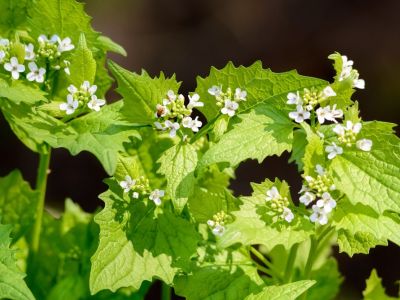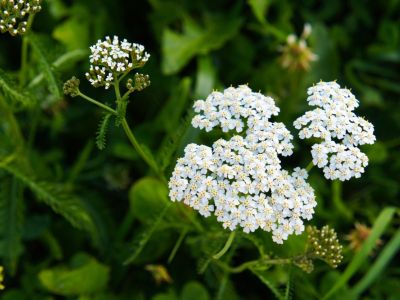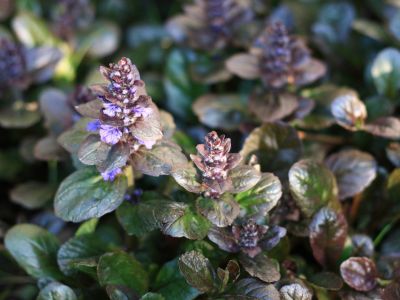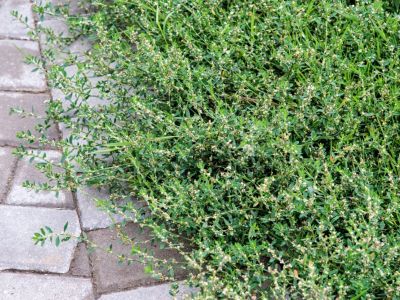Untreated weeds are like a disease. They can pretty much anywhere and in a range of different conditions. They can grow on your lawn, in the garden and between rocks. They can even find their way up through thick concrete.
But, can weeds grow in sand as well?
Yes, weeds can easily grow in sand as well, in fact it is no different and easy for weeds to pop through.
However, there are common misconceptions that sand can either prevent weed growth entirely or promote it.
In fact, the biggest problem with weeds is that they compete for and steal any nutrients as well as water and sunlight designated for crops, grass, flowers, etc. They, too, are growing organisms that want to thrive.
In this comprehensive guide, we will explore the relationship between weeds and sand, understanding the factors that contribute to weed growth in sandy environments, and providing expert tips for effective weed control.
Let’s debunk the myths and demystify the role of sand in weed growth.

The best way to deal with weeds is to remove them as early as possible to prevent them from getting out of hand and spreading.
Removing them from sand requires a little extra skill, though. Let’s dive deeper into how they grow in sand and how to stop them.
Table of Contents
Can Weeds Grow in Sand?
Weeds can grow in and up through the sand. Like any plant, they will do so as long as they are grown in the right conditions.
Let’s look at a paved area, for example. Pavers or stones are often laid on a bed of packed sand. If the wrong sand is used, that’s when weed problems can arrive.
The sand helps level the area out for paver/stone placement. Packed sandy areas are perfect for weeds to grow up into the paver gaps. They usually receive full sun and heat by warming up the pavers. They receive lots of water; the water can run down into the gaps between the stones.
They also don’t have any other plant to compete with for access to nutrients (which they don’t need much), so they get a free run. Lastly, as the weeds are removed, they drop their seeds, respawn even more, and the headaches continue! That is just one example of weeds growing in sand.
Why do Weeds Grow in Sand?
There are a few reasons weeds can easily grow in the sand. They seem pretty obvious when you think about them and how you’ve seen weeds grow. Let’s have a look at them in a little more detail.

No Shortage of Sunlights
Given that the sun is out in some capacity every day, weeds use the rays to their advantage to help them grow and thrive. Of course, in some geographic locations, the sun is up for less time than in others. Additionally, even if the sun is up, it may not produce the rays required for some weeds to grow.
That’s why you’ll often see fewer weeds in the colder, darker months of lesser sandy areas such as Scandinavia, Iceland, Greenland, Alaska, Siberia, parts of Russia, etc.
Weeds don’t require much nutrition
For them to grow out, weeds don’t need too much nutrition. They are cultivated survivors. Additionally, sand doesn’t offer much in the way of nutrition. So weeds can grow wild in the sand without breaking a sweat.
As the wind blows the weed seeds around, it’s easy for those seeds to dock and root. They need a little water and sun once they have landed to start shooting up.
Soil Compaction and Drainage
One advantage of sand is its ability to resist compaction. Weed seeds that require soil compaction to germinate may face difficulties in sand.
Additionally, the quick-draining nature of sand ensures excess water doesn’t pool, depriving weed seeds of the moisture they need to sprout.
How to Stops Weeds from Growing In Sand?
Weeds can cause big problems with irrigation, so they must be controlled. If you have a patch of sand that you want to keep free of weeds, then have no fear. Here are a few simple tips and solutions that you can use to ensure they stop growing.

Using Vinegar and Salt
Mixing salt, vinegar, and dishwashing liquid is a good natural solution that you can throw together using ingredients usually found at home. Simply mix 1 gallon (3.5-4 liters) of vinegar (5% acetic acid) with 1 cup of salt and 1 tablespoon of dish soap.
Add it to a spray bottle and spray it directly onto the weeds. This mix will burn the weeds from tip to root. The vinegar soaks the whole plant, drying it out, and the salt will finish it off using an osmosis process.
Using Herbicides & Chemicals
These measures should be used with care and as a last resort. Herbicides and Chemicals kill weeds and everything else around them, including other plants. They should not be used around animals or humans because they can be poisonous if accidentally breathed in or consumed.
They stop the photosynthesis process and choke out the plant leaving it to wilt and die. These solutions can be purchased at home depot stores and/or garden supplies.
Using Weed Barriers
Weed barriers are a great invention. They are more of a prevention method than a solution. You can lay the barriers down underneath the soil or sand. The barriers prevent weeds from growing up into the top layer of material. They are great for gardens and stone/paver areas.
Using Artificial Grass
Artificial grass works similar to weed barriers. They are effectively the same principle, except they also serve the purpose of aesthetics. You simply prepare the material the grass will sit on and roll out the synthetic grass over the top. The weeds won’t be able to grow up through these types of barriers.
Adding Mulch
Adding a thick layer of mulch to your garden will prevent weeds from growing by blocking the seeds from reaching the soil below. Weed seeds need soil, and if the mulch is thick enough, they will likely just perch themselves instead of planting and spawning in the soil. Additionally, the mulch will block out essential sunlight once perched down there.
Solarization
Solarization is a method that can be used by laying special tarps over the weed-filled area. This process traps heat under the tarps and kills the weeds and their seeds. It can take from 4-8 weeks to take effect, and it’s a great method to stop weeds from even starting to grow!
Reducing the Space Between Shrubs & Plants
Another preventive measure. By spacing your plants with little room between them, you are not allowing the weeds any space to grow their roots. The plants and shrubs will use all the nutrients, making it impossible for the weeds to thrive.

Manually Removing
As a last resort, you can remove the weeds by hand. There’s nothing like a bit of weed therapy when all else fails. At least this method can be done with absolute precision. You know exactly which one you are going for and can be sure you have removed it by the root.
Types of Weeds That Grow in the sand?
An extremely long list of weeds can easily grow in and amongst arid/dry sandy-type areas. Here is a list of some of the most common species.
Sorrel
- Growth: 2 ft (61cm).
- Characteristics:
- Long gangly green stems.
- Red (female) or yellow/green (male) bulb-shaped flowers.
- Green leaves flange from the base.
- Area: Grasslands.

Thistle Weed

- Growth: Anywhere from 30-80 inches (80-200cm)
- Characteristics:
- Spiky green bulb with a fluffy purple flower growing out the top.
- Hardy deep red stems.
- Prickly leaves flange from the base.
- Area:
- Open land.
- Fields.
Speedwell
- Growth: 1-3 ft (30-90cm).
- Characteristics:
- Small blue/purple flowers.
- Clover-shaped leaves grow as a base cover.
- Area:
- Grasslands.
- Open Woodlands.

Garlic mustard

- Growth: 4 ft (1m)
- Characteristics:
- Garlic/Onion odor when crushed.
- Small white flowers.
- Green flanged leaves growing from thin green stem.
- Area: Shaded forest floor.
Sandbur
- Growth: 20 inches (51cm).
- Characteristics:
- Rounded sharp spined burs.
- Reedy grass stems.
- Area: Beachy paths.

Yarrow

- Growth: 2-4 feet (50-100cm)
- Characteristics:
- Compact small white/yellow/red flowers.
- Leggy green stem.
- Spindly green leaves.
- Area:
- Open field.
- Grasslands.
Nettle
- Growth: 6-8 feet (1.8-2.4m),
- Characteristics:
- Flat green, soft mint like leaves.
- Leaves sting once touched. Brown/green stem.
- Forest trail.
- Area:
- Woodlands.
- Grasslands.
- Open fields.

Carpetweed

- Growth: 5 inches (13cm).
- Characteristics:
- Low ground cover.
- Green fanned, broad leaves.
- Stubborn green stems.
- Tilled gardens
- Area:
- Lawns.
- Roadside.
- Railway lines.
Pigweed
- Growth: 2-7 feet (60-210cm).
- Characteristics:
- Small green leaves.
- Stubborn brown, twiggy, fanned stems.
- Open sunny areas.
- Area:
- Fields.
- Grasslands.

Frequently Asked Questions (fAQs)
Does sand keep weeds from growing?
It depends on the type of sand that the weeds need to try to grow up through. For example, heavier sand mixed with other compounds such as cement can make the journey much tougher. Phorus, more natural sound, will allow weeds to grow without any degree of difficulty.
Do weeds go away on their own?
It depends on the species of weeds. Some are annual, for example, and they will go through their specific life cycle and die out. They will also most likely respawn in their next season. Also, the weeds in question could grow in a colder location where frost and snow could kill them. So technically, they aren’t going away for good, but it is quite possible for some time.
Does paver sand prevent weeds?
Using the right type and consistency of paver sand is designed to keep weeds away. On the other hand, the filler sand used for the gaps is generally much lighter. So if the weeds can make their way through the paver sand, then they will be able to grow through the gaps.
Does weed barrier fabric work in sandy soil?
Weed barrier fabrics can be effective in preventing weed growth in sandy soil if properly installed and maintained. However, they are not foolproof and may require additional measures to combat weeds, such as regular inspection and supplemental weed control methods.
Conclusion:
Weeds are like most plants because they will grow well as long as they are offered the right growing conditions. Optimal amounts of sunlight, water, nutrients and perfect soil conditions will allow anything to grow.
Weeds can grow in the sand because most sandy areas offer these conditions in abundance. We hope that you have found this article helpful! Happy growing!


